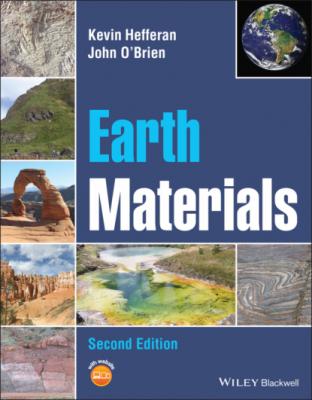Earth Materials. John O'Brien
Читать онлайн.| Название | Earth Materials |
|---|---|
| Автор произведения | John O'Brien |
| Жанр | География |
| Серия | |
| Издательство | География |
| Год выпуска | 0 |
| isbn | 9781119512219 |
The relative movement of plates with respect to the boundary that separates them defines three major types of plate boundary segments (Figure 1.4) and two hybrids: (1) divergent plate (2) convergent, (3) transform, (4) divergent‐transform hybrid, and (5) convergent‐transform hybrid.
Each type of plate boundary produces a characteristic suite of features and Earth materials. This relationship between the kinds of Earth materials formed and the plate tectonic settings in which they are produced provides a major theme of the chapters that follow.
1.5.2 Divergent plate boundaries
Divergent plate boundaries occur where two plates are moving apart relative to their boundary (Figure 1.4a). Such areas are characterized by horizontal extension and vertical thinning of the lithosphere. Horizontal extension in continental lithosphere is marked by continental rift systems and in oceanic lithosphere by the oceanic ridge system.
Continental rifts
Continental rifts form where large‐scale horizontal extension occurs in continental lithosphere (Figure 1.5). In such regions, the lithosphere is progressively stretched and thinned. A candy bar being very slowly stretched in two is a crude metaphor. This stretching occurs by brittle, normal, and detachment faulting near the cooler surface and by ductile flow at deeper, warmer levels. Long‐term extension is accompanied by uplift of the surface as the hot asthenosphere rises under the thinned lithosphere. Rocks near the surface of the lithosphere that rupture along normal and detachment faults produce continental rift valleys. The East African Rift, the Rio Grande Rift in the United States and the Dead Sea Rift in the Middle East are modern examples of continental rift valleys.
Figure 1.4 Principal types of plate boundaries: (a) divergent; (b) convergent; (c), transform; thick lines represent plate boundaries and black arrows indicate relative motion between plates; (d) hybrid convergent‐transform boundary; red arrows show components of convergent and transform relative motion.
Figure 1.5 Major features of continental rifts include rift valleys, thinned continental crust (blue) and lithosphere (brown) with volcanic‐magmatic activity from melts generated in rising asthenosphere (burnt orange).
If horizontal extension and vertical thinning occur for a sufficient period of time, the continental lithosphere may be completely rifted into two separate continents. Complete continental rifting is the diachronous process by which supercontinents such as Pangea and Rodinia were broken into smaller continents such as those we see on Earth's surface at present. When this happens, a new and growing ocean basin begins to form between the two continental fragments by the process of sea floor spreading (Figure 1.6). The most recent example of this occurred when the Saudi Arabian Peninsula separated from Africa to produce the Red Sea basin some 5 Ma. Older examples include the separation of India from Africa to produce the northwest Indian Ocean basin (c. 115 Ma) and the separation of the Americas from Africa to produce the Atlantic Ocean basin (beginning c. 190 Ma). Once the continental lithosphere has rifted completely, the divergent plate boundary is no longer situated within continental lithosphere. Its position is instead marked by a portion of the oceanic ridge system where oceanic crust is produced and grows by sea floor spreading (Figure 1.6).
Figure 1.6 Model showing the growth of ocean basins by sea floor spreading from the ridge system following the complete rifting of continental lithosphere along a divergent plate boundary. Separated continental crust (light blue, topped with yellow sediments) and recently formed oceanic crust (dark blue striped pattern) are produced.
Oceanic ridge system
The oceanic ridge system (ridge) is Earth's largest mountain range and covers roughly 20% of Earth's surface (Figure 1.7). The ridge is >65 000 km long, averages ~1500 km in width and rises to a crest with an average elevation of ~3 km above the surrounding sea floor. A moment's thought will show that the ridge system is only a broad swell on the ocean floor, whose slopes, on average, are very gentle. Since it rises only 3 km over a horizontal distance of 750 km, the average slope is 3 km/750 km which is about 0.004; the average slope is less than half a degree. We often exaggerate the vertical dimension on profiles and maps in order to make the subtle stand out. Still there are differences in relief along the ridge system. In general, warmer, faster spreading portions of the ridge such as the East Pacific Rise (~6–18 cm/yr) have gentler slopes than colder, slower spreading portions such as the Mid‐Atlantic Ridge (~2–4 cm/yr). The central or axial portion of the ridge system is commonly marked by a rift valley, especially along slower spreading segments. This marks the position of a divergent plate boundary in oceanic lithosphere (Figure 1.7).
Figure 1.7 Map of the ocean floor showing the distribution of the oceanic ridge system.
Source: World Ocean Floor Manuscript Map; drawn by Berann, H.C., US Library of Congress, public domain after Heezan, Bruce C. and Tharpe, Marie.
One of the most significant discoveries of the twentieth century (Dietz 1961; Hess 1962) was that oceanic crust forms along the axis of the ridge system, then spreads away from it in both directions, causing ocean basins to grow through time. The details of this process are illustrated by Figure 1.8. As the lithosphere is thinned, the asthenosphere rises toward the surface, generating basaltic‐gabbroic melts. Melts that crystallize in magma
